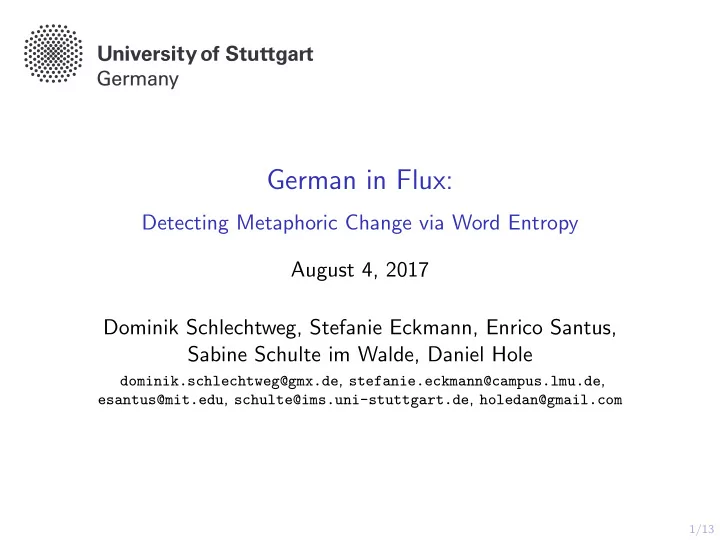

German in Flux: Detecting Metaphoric Change via Word Entropy August 4, 2017 Dominik Schlechtweg, Stefanie Eckmann, Enrico Santus, Sabine Schulte im Walde, Daniel Hole dominik.schlechtweg@gmx.de , stefanie.eckmann@campus.lmu.de , esantus@mit.edu , schulte@ims.uni-stuttgart.de , holedan@gmail.com 1/13
Introduction ◮ Our aim: ◮ overall : build a computational model detecting semantic change ◮ in this paper : distinguish metaphoric change from semantic stability ◮ How we do it: ◮ exploit the idea of semantic generality from hypernym detection ◮ apply entropy to distributional semantic model ◮ sample language German ◮ introduce the first resource for evaluation of models of metaphoric change 2/13
Shortcomings of Related Work ◮ Previous work includes mainly: (i) spatial displacement models (ii) word sense induction models ◮ quantify the degree of overall change rather than being able to qualify different types ◮ do not examine metaphoric change 3/13
Metaphoric Change ◮ frequent and important type of semantic change ◮ source and target concept are related by similarity or a reduced comparison (cf. Koch, 2016, p. 47) earlier: ... muß ich mich vmbweltzen / vnd kan keinen schlaff in meine augen bringen ‘... I have to turn around and cannot bring sleep into my eyes.’ later: Kinadon wollte den Staat umw¨ alzen ... ‘Kinadon wanted to revolutionize the state ...’ (i) creates polysemy (ii) often results in more abstract or general meanings → assumption: (i) and (ii) imply extension and dispersion in the range of linguistic contexts 4/13
Corpus ◮ Deutsches Textarchiv (erweitert) (DTA) ◮ large : provides more than 2447 lemmatized and POS-tagged texts (with more than 140M tokens) ◮ covers long time period : late 15 th to the early 20 th century ◮ balanced : includes literary and scientific texts as well as functional writings 5/13
Word Entropy ◮ corresponds to entropy of word vector ◮ is assumed to reflect semantic generality in hypernym detection ◮ is given by n � H ( C ) = − P ( c i | w ) log 2 P ( c i | w ) i =1 where P ( c i | w ) is the occurrence probability of context word c i given target word w ◮ measures the unpredictability of w ’s co-occurrences 6/13
Evaluation ◮ no standard test set of semantic or metaphoric change ◮ we create a small but first test set via annotation ( 28 items ) ◮ annotators judged 560 context pairs for a metaphorical relation Workflow: (i) preselect 14 changing words (ii) add 14 stable distractors (iii) identify a date of change (iv) extract 20 contexts for each target from before and after date of change (v) for each word combine contexts between time periods randomly (vi) annotation of context pairs 7/13
Annotation ◮ steps to identify metaphoric relation of C1 to C2: 1. Does any of these hold?: ◮ C1 is less concrete than C2 ◮ C1 is less human-oriented than C2 ◮ C1 is not related to bodily action in contrast to C2 ◮ C1 is less precise than C2 2. if yes: does C1 contrast with C2 but can be understood in comparison with it? ◮ agreement : κ (Fleiss’ Kappa) between . 40 and . 46 ◮ result is gold ranking of targets for strength of metaphoric change 8/13
Annotation Results target POS type date meaning score Donnerwetter N met 1805 thunderstorm > thunderstorm, blowup 0.78 ... Unh¨ oflichkeit N sta 1605 discourtesy 0.1 ... Table 1 : Sample of test set items ordered by their annotated degree of metaphoric change. 9/13
Results 1700-1800 1800-1900 all entropy .64*** .10 .39* frequency .29 -.07 .26 Table 2 : Correlation ( ρ ) between predicted and gold ranks. Significance is determined with a t-test. 10/13
Result Analysis ◮ ausstechen 1605: Von einem Bawren / welcher einem Kalbskopff die Augen außstach. ‘About a Farmer / who cut out the eyes of a calf’s head.’ 1869: Sie wollen ihre Aufgabe nicht nur l¨ osen, sondern auch elegant, d. h. rasch l¨ osen, um Nebenbuhler auszustechen. ‘They not only wanted to solve their task, but also elegantly, i.e., solve it fast, in order to excel rivals.’ ◮ gold rank: 12/28, entropy: 13, frequency: 17 ◮ Donnerwetter 1631: Die Lufft ist heiß / vnd gibt viel Blitzen vnd Donnerwetter ... ‘The air is hot / and there are many lightnings and thunderstorms ...’ 1893: Potz Donnerwetter! ‘Man alive!’ ◮ gold rank: 1/28, entropy: 27, frequency: 15 11/13
Conclusions ◮ you can annotate semantic change in a corpus (so do it) ◮ entropy correlates strongly and significantly with degree of metaphoric change ◮ frequency correlates moderately, but non-significantly on small data set ◮ annotation and model are generalizable to different types of semantic change https://github.com/Garrafao/MetaphoricChange 12/13
Recommend
More recommend